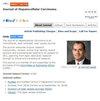MRI Radiomics Combined with Clinicopathological Factors for Predicting 3-Year Overall Survival of Hepatocellular Carcinoma After Hepatectomy
IF 4.2
3区 医学
Q2 ONCOLOGY
引用次数: 0
Abstract
Background: A limited number of studies have examined the use of radiomics to predict 3-year overall survival (OS) after hepatectomy in patients with hepatocellular carcinoma (HCC). This study develops 3-year OS prediction models for HCC patients after liver resection using MRI radiomics and clinicopathological factors.Materials and Methods: A retrospective analysis of 141 patients who underwent surgical resection of HCC was performed. Patients were randomized into two set: the training set (n=98) and the validation set (n=43) including the survival groups (n=111) and non-survival groups (n=30) based on 3-year survival after hepatectomy. Furthermore, x2 or Fisher’s exact test, univariate and multivariate logistic regression analyses were conducted to determine independent clinicopathological risk factors associated with 3-year OS. 1688 quantitative imaging features were extracted from preoperative T2-weighted imaging (T2WI) and contrast-enhanced magnetic resonance imaging (CE-MRI) of arterial phase (AP), portal venous phases (PVP)and delay period (DP). The features were selected using the variance threshold method, the select K best method and the least absolute shrinkage and selection operator (LASSO) algorithm. By using Bernoulli Naive Bayes (BernoulliNB) and Multinomial Naive Bayes (MultinomialNB) classifiers, we constructed models based on the independent clinicopathological factors and Rad-scores. To determine the best model, receiver operating characteristics (ROC) and Delong’s test were used. Moreover, calibration curves were used to determine the calibration ability of the model, while decision curve analysis (DCA) was implemented to evaluate its clinical benefit.
Results: The fusion model showed excellent prediction precision with AUC of 0.910 and 0.846 in training and validation set and revealed significant diagnostic accuracy and value in the calibration curve and DCA analysis.
Conclusion: Nomograms based on MRI radiomics and clinicopathological factors have significant predictive value for 3-year OS after hepatectomy and can be used for risk classification.
核磁共振成像放射组学结合临床病理因素预测肝细胞癌肝脏切除术后的 3 年总生存率
背景:利用放射组学预测肝细胞癌(HCC)患者肝切除术后3年总生存率(OS)的研究数量有限。本研究利用磁共振成像放射组学和临床病理因素建立了肝切除术后HCC患者3年OS预测模型:对141例接受手术切除的HCC患者进行回顾性分析。患者被随机分为两组:训练组(98 人)和验证组(43 人),其中包括根据肝切除术后 3 年生存率划分的生存组(111 人)和非生存组(30 人)。此外,还进行了x2或费雪精确检验、单变量和多变量逻辑回归分析,以确定与3年OS相关的独立临床病理风险因素。从术前T2加权成像(T2WI)和对比增强磁共振成像(CE-MRI)的动脉期(AP)、门静脉期(PVP)和延迟期(DP)中提取了1688个定量成像特征。采用方差阈值法、选择 K 最佳法和最小绝对收缩和选择算子(LASSO)算法选择特征。通过使用伯努利奈何贝叶斯(BernoulliNB)和多项式奈何贝叶斯(MultinomialNB)分类器,我们构建了基于独立临床病理因素和 Rad 评分的模型。为了确定最佳模型,我们使用了接收者操作特征(ROC)和德朗检验。此外,我们还使用校准曲线来确定模型的校准能力,并通过决策曲线分析(DCA)来评估其临床效益:结果:融合模型显示出极佳的预测精度,在训练集和验证集中的AUC分别为0.910和0.846,并且在校准曲线和DCA分析中显示出显著的诊断准确性和价值:基于MRI放射组学和临床病理因素的提名图对肝切除术后3年OS具有显著的预测价值,可用于风险分类。
本文章由计算机程序翻译,如有差异,请以英文原文为准。
求助全文
约1分钟内获得全文
求助全文

 求助内容:
求助内容: 应助结果提醒方式:
应助结果提醒方式:


